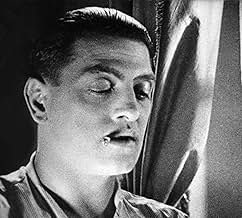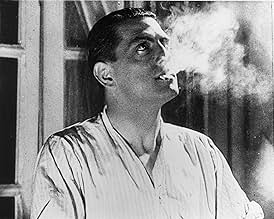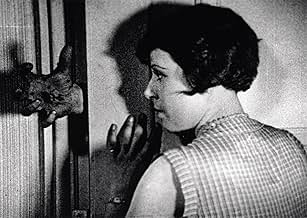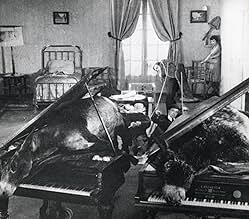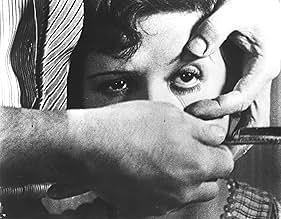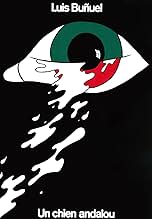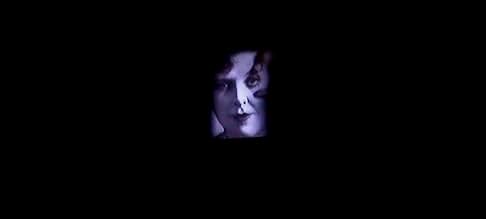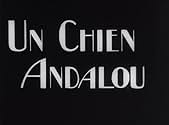VALUTAZIONE IMDb
7,6/10
55.280
LA TUA VALUTAZIONE
Luis Buñuel insieme a Salvador Dalí presentano un immaginario surreale e strano di sedici minuti.Luis Buñuel insieme a Salvador Dalí presentano un immaginario surreale e strano di sedici minuti.Luis Buñuel insieme a Salvador Dalí presentano un immaginario surreale e strano di sedici minuti.
Pierre Batcheff
- Man
- (as Pierre Batchef)
Simone Mareuil
- Young Girl
- (as Simonne Mareuil)
Luis Buñuel
- Man in Prologue
- (non citato nei titoli originali)
Pancho Cossío
- Stroller
- (non citato nei titoli originali)
Salvador Dalí
- Seminarist
- (non citato nei titoli originali)
Juan Esplandiu
- Stroller
- (non citato nei titoli originali)
Robert Hommet
- Young Man
- (non citato nei titoli originali)
Marval
- Seminarist
- (non citato nei titoli originali)
Fano Messan
- Hermaphrodite
- (non citato nei titoli originali)
Jaume Miravitlles
- Fat Seminarist
- (non citato nei titoli originali)
Recensione in evidenza
Luis Buñuel, Calanda, in the province of Teruel in the south of the region called Aragón, a town itself afamed for the twenty-four hour non-stop drums (`la tamborada') in the streets played by hundreds of people together in Holy Week, as a young man fled to Paris with the intention of doing something great in this world. There he met Salvador Dalí who had done the same, leaving his native Catalonia in his mid twenties - some five years younger than Buñuel - with more or less the same ideas in his head.
These two young men, who in later years were to be known - even admired in some cases - as the most extravagant and flamboyant creators of art, were not alone. Pablo Picasso, not yet 50, had already been blazing the trail, to mention another Spaniard among those thronging the avant-garde Paris of the times. Claude Debussy and Maurice Ravel had led the impressionist movement in music for many years, and the `Imagiste' school in poetry was well under way. Anybody who was anybody in the artistic world flocked to Paris, and either made a hit and became someone eminent, or did not.
Cinema was a new art form still to be experimented with; no wonder, then, that these two men of evidently original ideas trying to burst out of them, had to do something so as to gatecrash into the gentry of the established circles of artistes and would-be artistes or hangers-on. The Buñuel-Dalí tandem knew they would produce something different; not necessarily to scandalize anyone, but more with the purpose of attracting attention, whether from intellectuals, artists or their entrepreneurs, or just newspaper editors. Simply following the logical sequence that words can be poetic and an image is worth a thousand words, and that poetry can be abstract, thus so can images, and if they move - better still.
Buñuel got a bit of money out of his mother's purse, and thus the two young men had finance to start on making an abstract poetic sequence which did not pretend to have any logical meaning of any kind. `Un Chien Andalou' was to exist in the same way that any later painting either by Picasso or by Dalí himself would exist without necessarily purporting to mean anything, either significant or insignificant, and without necessarily any implicit objective - far less objective - raison d'etre than simply existing in itself. Whether the result could or should be considered `art' in any quintessential sense is/was up to the pundits, pseudointellectuals, newspaper critics, or anybody else who thought he had any ideas on the matter. Buñuel himself says in his autobiography `My Last Breath' that he would have quite happily burnt the film, but that would not have made any difference anyway.
`Un Chien Andalou' was the only silent film he made; whether because of lack of funds or otherwise intentionally, is hard to say. `L'Age d'Or' one year later had sound; however I cannot help thinking that Buñuel and Dali wanted to make a silent film, which then does not explain why in the 1960s Buñuel chose to add music - Wagner interspersed with a tango, a blatently at-odds combination - which would seem to have been some attempt at being unfaithful to the original. But Buñuel was nothing if not a contradictory person, to say the least. But by the 1960s he was beginning to turn out his best repertoire - `Viridiana' (qv), `Tristana', etc - and maybe his sense of maturity reigned over his other feelings, compelling him to `up-date' the film for newer audiences, even though he might be accused of unloyalty.
But, how does one remain loyal to abstract concepts which defy rationality?
Thus `Un Chien Andalou' remains one of the most misunderstood pieces of art to have ever been made public, and is perhaps the most widely-known short film of all time.
These two young men, who in later years were to be known - even admired in some cases - as the most extravagant and flamboyant creators of art, were not alone. Pablo Picasso, not yet 50, had already been blazing the trail, to mention another Spaniard among those thronging the avant-garde Paris of the times. Claude Debussy and Maurice Ravel had led the impressionist movement in music for many years, and the `Imagiste' school in poetry was well under way. Anybody who was anybody in the artistic world flocked to Paris, and either made a hit and became someone eminent, or did not.
Cinema was a new art form still to be experimented with; no wonder, then, that these two men of evidently original ideas trying to burst out of them, had to do something so as to gatecrash into the gentry of the established circles of artistes and would-be artistes or hangers-on. The Buñuel-Dalí tandem knew they would produce something different; not necessarily to scandalize anyone, but more with the purpose of attracting attention, whether from intellectuals, artists or their entrepreneurs, or just newspaper editors. Simply following the logical sequence that words can be poetic and an image is worth a thousand words, and that poetry can be abstract, thus so can images, and if they move - better still.
Buñuel got a bit of money out of his mother's purse, and thus the two young men had finance to start on making an abstract poetic sequence which did not pretend to have any logical meaning of any kind. `Un Chien Andalou' was to exist in the same way that any later painting either by Picasso or by Dalí himself would exist without necessarily purporting to mean anything, either significant or insignificant, and without necessarily any implicit objective - far less objective - raison d'etre than simply existing in itself. Whether the result could or should be considered `art' in any quintessential sense is/was up to the pundits, pseudointellectuals, newspaper critics, or anybody else who thought he had any ideas on the matter. Buñuel himself says in his autobiography `My Last Breath' that he would have quite happily burnt the film, but that would not have made any difference anyway.
`Un Chien Andalou' was the only silent film he made; whether because of lack of funds or otherwise intentionally, is hard to say. `L'Age d'Or' one year later had sound; however I cannot help thinking that Buñuel and Dali wanted to make a silent film, which then does not explain why in the 1960s Buñuel chose to add music - Wagner interspersed with a tango, a blatently at-odds combination - which would seem to have been some attempt at being unfaithful to the original. But Buñuel was nothing if not a contradictory person, to say the least. But by the 1960s he was beginning to turn out his best repertoire - `Viridiana' (qv), `Tristana', etc - and maybe his sense of maturity reigned over his other feelings, compelling him to `up-date' the film for newer audiences, even though he might be accused of unloyalty.
But, how does one remain loyal to abstract concepts which defy rationality?
Thus `Un Chien Andalou' remains one of the most misunderstood pieces of art to have ever been made public, and is perhaps the most widely-known short film of all time.
- khatcher-2
- 16 nov 2003
- Permalink
Trama
Lo sapevi?
- QuizAt the Paris premiere, Luis Buñuel hid behind the screen with stones in his pockets for fear of being attacked by the confused audience. Nothing of the sort happened. In fact, the audience loved its mysterious and incomprehensible plot.
- Versioni alternativeThe film was re-released in 1960 with soundtracks.
- ConnessioniEdited into Avant-garde Cinema (1960)
I più visti
Accedi per valutare e creare un elenco di titoli salvati per ottenere consigli personalizzati
Dettagli
- Data di uscita
- Paese di origine
- Lingua
- Celebre anche come
- Un Chien Andalou
- Luoghi delle riprese
- Vedi altri crediti dell’azienda su IMDbPro
- Tempo di esecuzione16 minuti
- Colore
- Mix di suoni
- Proporzioni
- 1.33 : 1
Contribuisci a questa pagina
Suggerisci una modifica o aggiungi i contenuti mancanti

Divario superiore
By what name was Un cane andaluso (1929) officially released in India in English?
Rispondi








